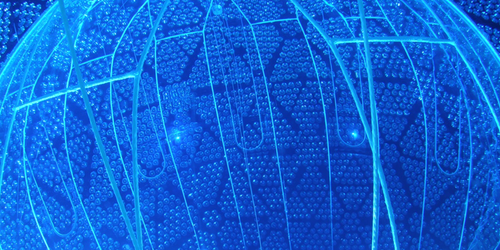Reactor Neutrinos Detected by Water
In a mine in Sudbury, Canada, the SNO+ detector is being readied to search for a so-far-undetected nuclear-decay process. Spotting this rare decay would allow researchers to confirm that the neutrino is its own antiparticle (see Viewpoint: Probing Majorana Neutrinos). But while SNO+ team members prepare for that search, they have made another breakthrough by capturing the interaction with water of antineutrinos from nuclear reactors [1]. The finding offers the possibility of making neutrino detectors from a nontoxic material that is easy to handle and inexpensive to obtain, key factors for use of the technology in auditing the world’s nuclear reactors (see Feature: Neutrino Detectors for National Security).
The SNO+ detector was inherited from the earlier Sudbury Neutrino Observatory (SNO) experiment. Today the detector is filled with a liquid that lights up when charged particles pass through it. But in 2018, to calibrate the detector’s components and to characterize its intrinsic radioactive background signal after the experiment’s upgrade, it contained water. The antineutrino signal was observed when, after completing those measurements, the researchers took the opportunity to carry out additional experiments before the liquid was switched out.
Analyzing that 2018 data, the team found a 3-sigma signal that matched that expected for antineutrinos coming from nuclear reactors at least 240 km away. “It intrigues us that pure water can be used to measure antineutrinos from reactors and at such large distances,” says SNO+ Collaboration member Logan Lebanowski. “We spent significant effort to extract a handful of signals from 190 days of data. The result is gratifying.”
–Katherine Wright
Katherine Wright is the Deputy Editor of Physics Magazine.
References
- A. Allega et al. (SNO+ Collaboration), “Evidence of antineutrinos from distant reactors using pure water at SNO+,” Phys. Rev. Lett. 130, 091801 (2023).




